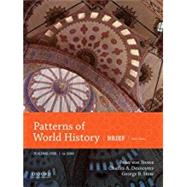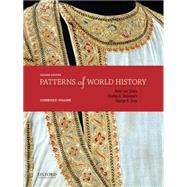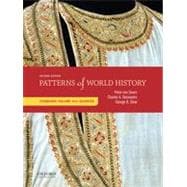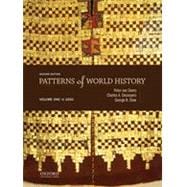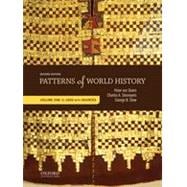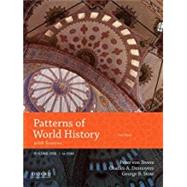Patterns of World History Volume Two: Since 1400
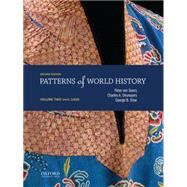
Patterns of World History Volume Two: Since 1400
- ISBN 13:
9780199399635
- ISBN 10:
0199399638
- Edition: 2nd
- Format: Paperback
- Copyright: 10/28/2014
- Publisher: Oxford University Press
- Newer Edition
List Price $105.54 Save $28.03
Usually Ships in 24-48 Hours
We Buy This Book Back!
Free Shipping On Every Order
Note: Supplemental materials are not guaranteed with Rental or Used book purchases.
Extend or Purchase Your Rental at Any Time
Need to keep your rental past your due date? At any time before your due date you can extend or purchase your rental through your account.
Summary
Patterns of World History offers a distinct framework for understanding the global past through the study of origins, interactions, and adaptations. Authors Peter von Sivers, Charles A. Desnoyers, and George Stow--each specialists in their respective fields--examine the full range of human ingenuity over time and space in a comprehensive, even-handed, and critical fashion.
The book helps students to see and understand patterns through: ORIGINS - INTERACTIONS - ADAPTATIONS
These key features show the O-I-A framework in action:
* Seeing Patterns, a list of key questions at the beginning of each chapter, focuses students on the 3-5 over-arching patterns, which are revisited, considered, and synthesized at the end of the chapter in Thinking Through Patterns
* Each chapter includes a Patterns Up Close case study that brings into sharp relief the O-I-A pattern using a specific idea or thing that has developed in human history (and helped, in turn, develop human history), like the innovation of the Chinese writing system or religious syncretism in India. Each case study clearly shows how an innovation originated either in one geographical center or independently in several different centers. It demonstrates how, as people in the centers interacted with their neighbors, the neighbors adapted to--and in many cases were transformed by--the idea, object, or event. Adaptations include the entire spectrum of human responses, ranging from outright rejection to creative borrowing and, at times, forced acceptance.
Author Biography
Read morePeter von Sivers is Associate Professor of History at the University of Utah.
Charles A. Desnoyers is Professor of History and Director of Asian Studies at La Salle University.
George B. Stow is Professor of History and the Director of the Graduate Program in History at La Salle University.
Table of Contents
Read moreMaps
Studying with Maps
Preface
Note on Dates and Spellings
About the Authors
Part One: From Human Origins to Early Agricultural Centers, Prehistory-600 BCE
Chapter 1: Prehistory-10,000 BCE
The African Origins of Humanity
The Origins of Humanity
Hominins: No Longer Apes but Not Yet Human
Human Adaptations: From Africa to Eurasia and Australia
The African Origins of Human Culture
Migration from South Asia to Australia
Migration from South Asia to Europe
The Ice Age Crisis and Human Migration to the Americas
The Ice Age
Migration to the Americas
Patterns Up Close: The Disappearance of Neanderthals
Against the Grain: The Hobbits of Flores Island
Putting It All Together
(with Sources)
Patterns of Evidence: Sources for Chapter 1
1.1 Shell bead jewelry from the Grotte des Pigeons, Taforalt, Morocco
1.2 Python-shaped, ornamented rock found in the Rhino Cave, Botswana
1.3 Paintings in the Cave of Altamira, Santillana del Mar, Spain
1.4 Flax fibers found at the Dzudzuana Cave, Republic of Georgia, Caucasus Mountains
Chapter 2: Agrarian-Urban Centers of the Middle East and Eastern Mediterranean, 11,500-600 BCE
Agrarian Origins in the Fertile Crescent, ca. 11,500-1500 BCE
Sedentary Foragers and Foraging Farmers
The Origin of Urban Centers in Mesopotamia and Egypt
Kingdoms in Mesopotamia, Egypt, and Crete
Interactions Among Multiethnic and Multireligious Empires, ca. 1500-600 BCE
The Hittite and Assyrian Empires, 1600-600 BCE Small Kingdoms on the Imperial Margins, 1600-600 BCE
Religious Experience and Cultural Achievements
Patterns Up Close: Babylonian Law Codes
Against the Grain: Akhenaten The Transgressor
Putting It All Together
(with Sources)
Patterns of Evidence: Sources for Chapter 2
2.1 Law Code of Hammurabi
2.2 Babylonian Poem of the Righteous Sufferer
2.3 Advice from a royal scribe to his apprentice, Middle Kingdom Egypt, Twelfth Dynasty
2.4 Sketch of the palace complex at Knossos, Minoan Crete
2.5 The Great Hymn to the Aten
Chapter 3: Shifting Agrarian Centers in India, 3000-600 BCE
The Vanished Origins of Harappa, 3000-1500 BCE
The Region and People
Adapting to Urban Life in the Indus Valley The Collapse of the Cities
Interactions in Northern India, 1500-600 BCE
The Vedic World, 1750-800 BCE
Statecraft and the Ideology of Power, 800-600 BCE
Indian Society, Culture, and Religion, 1500-600 BCE
Society and Family in Ancient India
Cultural Interactions to 600 BCE
Patterns Up Close: The Caste System
Against the Grain: A Merchants' Empire?
Putting It All Together
(with Sources)
Patterns of Evidence: Sources for Chapter 3
3.1 Hymns to Agni, from the Rig-Veda, Book 2
3.2 The Bhagavad Gita
3.3 The Brihadaranyaka Upanishad
3.4 The Code of Manu
3.5 Image of Draupadi and the Pandava, from the Dashavatara Temple, Deogarh, India
Chapter 4: Agrarian Centers and the Mandate of Heaven in Ancient China, 5000-481 BCE
The Origins of Yellow River Cultures, 5000-1766 BCE
Geography and Climate
The Origins of Neolithic Cultures
The Age of Myth and the Xia Dynasty, 2852-1766 BCE
The Interactions of Shang and Zhou History and Politics, 1766-481 BCE
The Shang Dynasty, 1766-1122 BCE
The Mandate of Heaven: The Zhou Dynasty to 481 BCE
Economy, Society, and Family Adaptation in Ancient China
Shang Society
Interactions of Zhou Economy and Society
Gender and the Family
Interactions of Religion, Culture, and Intellectual Life in Ancient China
Oracle Bones and Early Chinese Writing
Adaptations of Zhou Religion, Technology, and Culture
Patterns Up Close: The Chinese Writing System
Against The Grain: Women's Voices
Putting It All Together
(with Sources)
Patterns of Evidence: Sources for Chapter 4
4.1 The Zuo Commentary (Zuozhuan)
4.2 Excerpts from The Book of Odes (Shijing)
4.3 The Book of Lord Shang (Shangjun Shu)
4.4 The Canon of Shun
4.5 Iron sword with jade handle, earliest cast-iron object (Western Zhou), from Henan Museum, Guo state, Sanmenxia city
Chapter 5: Origins Apart: The Americas and Oceania, 30,000-600 BCE
The Americas: Hunters and Foragers, 30,000-600 BCE
The Environment
Human Migrations
Agriculture, Villages, and Urban Life
The Neolithic Revolution in the New World
The Origins of Urban Life
The First Mesoamerican Settlements
Foraging and Farming Societies Outside the Andes and Mesoamerica
The Origins of Pacific Island Migrations, 6000-600 BCE
Lapita and Cultural Origins
Creating Polynesia
Patterns Up Close: The Origin of Corn
Against the Grain: Thor Heyerdahl
Putting It All Together
(with Sources)
Patterns of Evidence: Sources for Chapter 5
5.1 Quipú from the Caral-Supé Culture, Peru
5.2 Textile fragment from Chavín de Huántar, Peru
5.3 Burial Mound at L'Anse Amour, Labrador, Canada
5.4 Lapita Pot Shards, found in Vanuatu, Western Pacific
Part Two: The Age of Empires and Visionaries, 600 BCE-600 CE
Chapter 6: Chiefdoms and Early States in Africa and the Americas, 600 BCE-600 CE
Agriculture and Early African Kingdoms
Saharan Villages, Towns, and Kingdoms
The Kingdom of Aksum
The Spread of Villages in Sub-Saharan Africa
West African Savanna and Rain-Forest Agriculture
The Spread of Village Life to East and South Africa
Patterns of African History, 600 BCE-600 CE
Early States in Mesoamerica: Maya Kingdoms and Teotihuacán
The Maya Kingdoms in Southern Mesoamerica
The Kingdom of Teotihuacán in the Mexican Basin
The Andes: Moche and Nazca
The Moche in Northern Peru
Paracas and the Nazca in Southern Peru
Patterns Up Close: The Mayan Ball Game
Against the Grain: Nazca Lines and Speculation
Putting It All Together
(with Sources)
Patterns of Evidence: Sources for Chapter 6
6.1 Relief sculpture from Meroë, Sudan
6.2 Cosmas Indicopleustes (Cosmas the India-Voyager), Christian Topography
6.3 The market at Jenné-jeno, Mali
6.4 Limestone panel from a Mayan temple, Palenque
Chapter 7: Persia, Greece, and Rome, 550 BCE-600 CE
Interactions Between Persia and Greece
The Origins of the Achaemenid Persian Empire
Greek City-States in the Persian Shadow
Alexander's Empire and Its Successor Kingdoms
Interactions Between the Persian and Roman Empires
Parthian Persia and Rome The Sasanid Persian and Late Roman Empires
Adaptations to Monotheism and Monism in the Middle East
Challenge to Polytheism: The Origins of Judaism, Zoroastrianism, and Greek Philosophy
Toward Religious Communities and Philosophical Schools
The Beginnings of Science and the Cultures of Kings and Citizens
The Sciences at the Museum of Alexandria
Royal Persian Culture and Arts
Greek and Roman Civic Culture and Arts
Patterns Up Close: The Plague of Justinian
Against the Grain: Women in Democratic Athens
Putting It All Together
(with Sources)
Patterns of Evidence: Sources for Chapter 7
7.1 The Cyrus Cylinder
7.2 Herodotus, Histories
7.3 1 Maccabees
7.4 Graffiti from the walls of Pompeii
7.5 The murder of the philosopher Hypatia, Alexandria, Egypt
Chapter 8: Empires and Visionaries in India, 600 BCE-600 CE
Patterns of State Formation in India: Republics, Kingdoms, and Empires
The Road to Empire: The Mauryas
The Classical Age: The Gupta Empire
The Southern Kingdoms, ca. 300-600 CE
The Vedic Tradition and Its Visionary Reformers
Reforming the Vedic Tradition
The Maturity of Hinduism: From the Abstract to the Devotional
Stability Amid Disorder: Economics, Family, and Society
Tax and Spend: Economics and Society
Caste, Family Life, and Gender
Strength In Numbers: Art, Literature, and Science
Patterns Up Close: The Global Trade of Indian Pepper
Against the Grain: India's Ancient Republics
Putting It All Together
(with Sources)
Patterns of Evidence: Sources for Chapter 8
8.1 The Seven Pillar Edicts of King Ashoka
8.2 The Questions of King Milinda (The Milindapanha)
8.3 Bamiyan Buddhas, Afghanistan
8.4 Seated Buddha, from the Gandhara culture, Afghanistan-Pakistan
8.5 Kalidasa, The Cloud Messenger
Chapter 9: China: Imperial Unification and Perfecting the Moral Order, 722 BCE-618 CE
Visionaries and Empire
Confucianism, Legalism, and Daoism
The Qin Dynasty
The Han Dynasty
The Domestic Economy: Society, Family, and Gender
Industry and Commerce
Gender Roles
Intellectual Trends, Aesthetics, Science, and Technology
Confucianism, Education, and History During the Han
Buddhism in China
Intellectual Life
Patterns Up Close: The Stirrup
Against the Grain: Yang Zhu and Mo Di
Putting It All Together
(with Sources)
Patterns of Evidence: Sources for Chapter 9
9.1 Analects (Lunyu) of Confucius
9.2 Book of Mencius (Mengzi)
9.3 Li Si, "Memorial on the Burning of Books," from the Shiji
9.4 Han Shu (History of the Former Han Dynasty)
9.5 Ban Zhao, Admonitions for Women (Nüjie)
Part Three: The Formation of Religious Civilizations, 600-1450 CE
Chapter10: Islamic Civilization and Byzantium, 600-1300 CE
The Formation of Islamic Religious Civilization
The Beginnings of Islam
Islamic Theology, Law, and Politics
Eastern Christian Civilization in Byzantium
Byzantium's Difficult Beginnings
The Seljuk Invasion and the Crusades
Islamic and Eastern Christian Civilizations at Their Height
State and Society in Mamluk Egypt
Byzantine Provincial and Central Organization
Commercial Relations from the Atlantic to the South China Sea
Religion, Sciences, and the Arts in Two Religious Civilizations
Islamic Culture: Intellectual and Scientific Expressions
Artistic Expressions in Islamic Civilization
Patterns Up Close: Byzantine Icons and Islamic Miniatures
Against the Grain: Did Ibn Taymiyya "Have a Screw Loose"?
Putting It All Together
(with Sources)
Patterns of Evidence: Sources for Chapter 10
10.1 Excerpts from the Quran, Sura 2 "The Cow"
10.2 Documents related to the iconoclasm controversy
10.3 Memoirs of Usamah Ibn Munqidh
10.4 A Jewish engagement contract from Fustat (Old Cairo)
10.5 The Alchemy of Happiness, by Abd al-Hamid al-Ghazali
Chapter 11: Innovation and Adaptation in the Western Christian World, 600-1450 CE
The Formation of Christian Europe, 600-1000
Frankish Gaul and Latin Christianity
Recovery, Reform, and Innovation, 1000-1300
The Political Recovery of Europe
The Economic and Social Recovery of Europe
Religious Reform and Expansion
Intellectual and Cultural Developments
Crisis and Creativity, 1300-1415
The Calamitous Fourteenth Century
Signs of a New Era in the Fifteenth Century
Patterns Up Close: The Gothic Cathedral
Against the Grain: The Cathar Heresy
Putting It All Together
(with Sources)
Patterns of Evidence: Sources for Chapter 11
11.1 Einhard's Life of Charlemagne
11.2 Feudal contracts and the swearing of fealty
11.3 Peter Abelard, The Story of My Misfortunes
11.4 Giovanni Boccaccio, The Decameron, "Putting the Devil Back in Hell"
11.5 Flagellants attempt to ward off the Black Death in Germany and in England
Chapter 12: Contrasting Patterns in India and China, 600-1600 CE
India: The Clash of Cultures
India After the Guptas
Islam in India, 711-1398
Toward the Mughal Era, 1398-1450
Interactions and Adaptations: From Buddhism to Neo-Confucian Synthesis in China
Creating a Religious Civilization Under the Tang
The Song and Yuan Dynasties, 960-1368
The Ming to 1450: The Quest for Stability
Society, Family, and Gender
Perceptions of Perfection: Intellectual, Scientific, and Cultural Life
Patterns Up Close: Gunpowder
Against the Grain: Empress Wu
Putting It All Together
(with Sources)
Patterns of Evidence: Sources for Chapter 12
12.1 The Chachnamah
12.2 Harsha Vardhana, The Lady of the Jewel Necklace
12.3 Poetry of the Tang Dynasty
12.4 Marco Polo, "Kubilai Khan at War"
12.5 Model of a Ming ship in the flotilla of Zheng He
Chapter 13: Religious Civilizations Interacting: Korea, Japan, and Vietnam, 550-1500 CE
Korea to 1450: Innovation from Above
People and Place: The Korean Environment
Conquest and Competition: History and Politics to 1598
Economy, Society, and Family
Religion, Culture, and Intellectual Life
Japan to 1450: Selective Interaction and Adaptation
The Island Refuge
Adaptation at Arm's Length: History and Politics
Economy, Society, and Family
Religion, Culture, and Intellectual Life
Vietnam: Human Agency and State Building
The Setting and Neolithic Cultures
Economy, Society, and Family
Religion, Culture, and Intellectual Life
Patterns Up Close: Printing
Against the Grain: Zen and Bushido
Putting It All Together
(with Sources)
Patterns of Evidence: Sources for Chapter 13
13.1 Murasaki Shikibu, The Tale of Genji
13.2 Haedong kosung chon, on Buddhism in Korea
13.3 Nihongi (Chronicles of Japan)
13.4 P'i Jih-hsiu, "Three Poems of Shame"
13.5 Copper head of Bodhisattva Avalokiteshvara, Vietnam
Chapter 14: Patterns of State Formation in Africa, 600-1450 CE
Christians and Muslims in the Northeast
Nubia in the Middle Nile Valley
Ethiopia in the Eastern Highlands
Adaptation to Islam: City-States and Kingdoms in East and South Africa
The Swahili City-States on the East African Coast
Traditional Kingdoms in South and Central Africa
Central African Chiefdoms and Kingdoms
Cultural Encounters: West African Traditions and Islam
The Kingdom of Ancient Ghana
The Empire of Mali
Rain-Forest Kingdoms
Patterns Up Close: The Sculptures of Ife
Against the Grain: Sundiata's Rise to Power
Putting It All Together
(with Sources)
Patterns of Evidence: Sources for Chapter 14
14.1 The Fetha Nagast, Ethiopia
14.2 Ibn Battuta On Mali, from the Rihla
14.3 Golden Bracelets from the "Lost City" of Mapungubwe, South Africa
14.4 'Abd al-'Aziz al-Bakri?, Description of West Africa
14.5 Walls and moats at Sungbo's Eredo, Nigeria
Chapter 15: The Rise of Empires in the Americas, 600-1550 CE
The Legacy of Teotihuacán and the Toltecs in Mesoamerica
Militarism in the Valley of Mexico
Late Maya States in Yucatán
The Legacy of Tiwanaku and Wari in the Andes
The Expanding State of Tiwanaku
The Expanding City-State of Wari
American Empires: Aztec and Inca Origins and Dominance
The Aztec Empire of Mesoamerica
The Inca Empire of the Andes
Imperial Society and Culture
Imperial Capitals: Tenochtitlán and Cuzco
Power and Its Cultural Expressions
Patterns Up Close: Human Sacrifice and Propaganda
Against the Grain: Amazon Rainforest Civilizations
Putting It All Together
(with Sources)
Patterns of Evidence: Sources for Chapter 15
15.1 The Temple of the Jaguars, Chichén Itzá
15.2 Skeletons in a Wari royal tomb site, El Castillo de Huarmey, Peru
15.3 Bernal Díaz, The Conquest of New Spain
15.4 Pedro Cieza de León on Incan roads
15.5 Garcilaso de la Vega, "The Walls and Gates of Cuzco"
Part Four: Interactions Across the Globe, 1450-1750
Chapter 16: Western European Overseas Expansion and the Ottoman-Habsburg Struggle, 1450-1650
The Muslim-Christian Competition in the East and West, 1450-1600
Iberian-Christian Expansion, 1415-1498
Rise of the Ottomans and Struggle with the Habsburgs for Dominance, 1300-1609
The Centralizing State: Origins and Interactions
State Transformation, Money, and Firearms
Imperial Courts, Urban Festivities, and the Arts
The Ottoman Empire: Palaces, Festivities, and the Arts
The Spanish Habsburg Empire: Popular Festivities and the Arts
Patterns Up Close: Shipbuilding
Against the Grain: Tilting at Windmills
Putting It All Together
(with Sources)
Patterns of Evidence: Sources for Chapter 16
16.1 Christopher Columbus, The Book of Prophecies
16.2 Thomas the Eparch and Joshua Diplovatatzes, "The Fall of Constantinople"
16.3 Evliya Çelebi, "A Procession of Artisans at Istanbul"
16.4 Ogier Ghiselin de Busbecq, "The Court of Suleiman the Magnificent
16.5 Janissary musket
Chapter 17: The Renaissance, New Sciences, and Religious Wars in Europe, 1450-1750
Cultural Transformations: Renaissance, New Science, and Early Enlightenment
The Renaissance and Baroque Arts
The New Sciences
The New Sciences and Their Social Impact
The New Sciences: Philosophical Interpretations
Centralizing States and Religious Upheavals
The Rise of Centralized Kingdoms
The Protestant Reformation, State Churches, and Independent Congregations
Religious Wars and Political Restoration
Patterns Up Close: Mapping the World
Against the Grain: The Digger Movement
Putting It All Together
(with Sources)
Patterns of Evidence: Sources for Chapter 17
17.1 Examination of Lady Jane Grey, London
17.2 Sebastian Castellio, Concerning Whether Heretics Should Be Persecuted
17.3 Duc de Saint-Simon, "The Daily Habits of Louis XIV at Versailles"
17.4 Giorgio Vasari, The Life of Michelangelo Buonarotti
17.5 Galileo Galilei, Letter to the Grand Duchess Christina de' Medici
Chapter 18: New Patterns in New Worlds: Colonialism and Indigenous Responses in the Americas, 1500-1800
The Colonial Americas: Europe's Warm-Weather Extension
The Conquest of Mexico and Peru The Establishment of Colonial Institutions
The Making of American Societies: Origins and Transformations
Exploitation of Mineral and Tropical Resources
Social Strata, Castes, and Ethnic Groups
The Adaptation of the Americas to European Culture
Patterns Up Close: The Columbian Exchange
Against the Grain: Juana Inés de la Cruz:
Putting It All Together
(with Sources)
Patterns of Evidence: Sources for Chapter 18
18.1 Hernán Cortés, Second Letter from Mexico to Emperor Charles V
18.2 Marina de San Miguel's Confessions before the Inquisition, Mexico City
18.3 Nahuatl Land Sale Documents, Mexico
18.4 The Jesuit Relations, French North America
18.5 The Salem Witch Trials, British North America
Chapter 19: African Kingdoms, the Atlantic Slave Trade, and the Origins of Black America, 1450-1800
African States and the Slave Trade
The End of Empires in the North and the Rise of States in the Center
Portugal's Explorations Along the African Coast and Contacts with Ethiopia
Coastal Africa and the Atlantic Slave Trade
American Plantation Slavery and Atlantic Mercantilism
The Special Case of Plantation Slavery in the Americas
Slavery in British North America
The Fatal Triangle: The Economic Patterns of the Atlantic Slave Trade
Culture and Identity in the African Diaspora
A New Society: Creolization of the Early Atlantic World
Patterns Up Close:Voodoo and Other New World Slave Religions
Against the Grain: Oglethorpe's Free Colony
Putting It All Together
(with Sources)
Patterns of Evidence: Sources for Chapter 19
19.1 Abd al-Rahman al-Saadi on the Scholars of Timbuktu
19.2 Letter of Nzinga Mbemba (Afonso I) of Kongo to the King of Portugal
19.3 Documents concerning the slave ship Sally, Rhode Island
19.4 The Interesting Narrative of the Life of Olaudah Equiano
19.5 Castas Paintings, Mexico
Chapter 20: The Mughal Empire: Muslim Rulers and Hindu Subjects,1400-1750
History and Political Life of the Mughals
From Samarkand to Hindustan
The Summer and Autumn of Empire
Administration, Society, and Economics
Mansabdars and Bureaucracy
The Mughals and Early Modern Economics
Society, Family, and Gender
Science, Religion, and the Arts
Science and Technology
Religion: In Search of Balance
Literature and Art
Patterns Up Close: Akbar's Attempt at Religious Synthesis
Against the Grain: Sikhism in Transition
Putting It All Together
(with Sources)
Patterns of Evidence: Sources for Chapter 20
20.1 Babur, The Baburnama
20.2 Muhammad Dara Shikuh, The Mingling of Two Oceans
20.3 Edicts of Aurangzeb
20.4 Muhammad Ghawth Gwaliori, The Five Jewels
20.5 Calico textile
Chapter 21: Regulating the "Inner" and "Outer" Domains: China and Japan, 1500-1800
Late Ming and Qing China to 1750
From Expansion to Exclusion
The Spring and Summer of Power: The Qing to 1750
Village and Family Life
Science, Culture, and Intellectual Life
The Long War and Longer Peace: Japan, 1450-1750
The Struggle for Unification
The Tokugawa Bakufu to 1750
Growth and Stagnation: Economy and Society
Hothousing "Japaneseness": Culture, Science, and Intellectual Life
Patterns Up Close: The "China" Trade
Against the Grain: Seclusion's Exceptions
Putting It All Together
(with Sources)
Patterns of Evidence: Sources for Chapter 21
21.1 Treaty between Koxinga and the Dutch government, Formosa
21.2 Matteo Ricci, China in the Sixteenth Century
21.3 Emperor Qianlong's Imperial Edict to King George III
21.4 Chikamatsu Monzaemon, Goban Taiheiki
21.5 Honda Toshiaki, "Secret Plan for Managing the Country"
Part Five: The Origins of Modernity, 1750-1900
Chapter 22: Patterns of Nation-States and Culture in Europe and North America, 1750-1871
Origins of the Nation-State: 1750-1815
The American, French, and Haitian Revolutions
Enlightenment Culture: Radicalism and Moderation
The Enlightenment and Its many Expressions
The Other Enlightenment: The Ideology of Ethnolinguistic Nationalism
The Growth of the Nation-State, 1815-1871
Restoration Monarchies, 1815-1848
Nation-State Building in Anglo-America, 1783-1865
Romanticism and Realism: Philosophical and Artistic Expression to 1850
Romanticism
Realism
Patterns Up Close: The Guillotine
Against the Grain: Defying the Third Republic
Putting It All Together
(with Sources)
Patterns of Evidence: Sources for Chapter 22
22.1 Declaration of the Rights of Man and of the Citizen
22.2 Olympe de Gouges, The Declaration of the Rights of Woman
22.3 Voltaire, "Torture" from the Philosophical Dictionary
22.4 Edmund Burke, Reflections on the Revolution in France
22.5 Thomas Paine, Rights of Man
Chapter 23: Creoles and Caudillos: Latin America and the Caribbean in the Nineteenth Century, 1790-1917
Independence, Authoritarianism, and Landed Elites
Independence and Southern and Western South American Politics
Independence and Development in Northern South America
Independence and Political Development in the North: Mexico
Brazil: From Kingdom to Republic
Latin American Society and Economy in the Nineteenth Century
Rebuilding Societies and Economies
Export-Led Growth
Culture, Family, and the Status of Women
Patterns Up Close: Slave Rebellions in Cuba and Brazil
Against the Grain: Early Industrialization in Chile?
Putting It All Together
(with Sources)
Patterns of Evidence: Sources for Chapter 23
23.1 Memoirs of General Antonio López de Santa Anna
23.2 Simón Bolívar, "The Jamaica Letter"
23.3 Domingo Faustino Sarmiento, Travels in the United States in 1847
23.4 Amulet containing passages from the Qur'an, worn by Muslim slaves who rioted in Bahia, Brazil
23.5 Photograph of a Chinese coolie, Peru
Chapter 24: The Challenge of Modernity: East Asia, 1750-1910
China and Japan in the Age of Imperialism
China and Maritime Trade, 1750-1839
The Opium Wars and the Treaty Port Era
Toward Revolution: Reform and Reaction to 1900
In Search of Security Through Empire: Japan in the Meiji Era
Economics and Society in Late Qing China
The Seeds of Modernity and the New Economic Order
Culture, Arts, and Science
Zaibatsu and Political Parties: Economics and Society in Meiji Japan
Commerce and Cartels
"Enlightenment and Progress": Science, Culture, and the Arts
Patterns Up Close: Interaction and Adaptation: "Self-Strengthening" and "Western Science and Eastern Ethics"
Against the Grain: Reaction to Modernity
Putting It All Together
(with Sources)
Patterns of Evidence: Sources for Chapter 24
24.1 Lin Zexu's Letter to Queen Victoria of Great Britain
24.2 Narrative of the British ship Nemesis during the First Opium War
24.3 LA Boxer rebel and a British family killed during the Boxer Rebellion
24.4 The Meiji Constitution of the Empire of Japan
24.5 Natsume Soseki, Kokoro
Chapter 25: Adaptation and Resistance: The Ottoman and Russian Empires, 1683-1908
Decentralization and Reforms in the Ottoman Empire
Ottoman Imperialism in the 1600s and 1700s
The Western Challenge and Ottoman Responses
Iran's Effort to Cope with the Western Challenge
Westernization, Reforms, and Industrialization in Russia
Russia and Westernization
Russia in the Early Nineteenth Century
The Great Reforms
Russian Industrialization
The Abortive Russian Revolution of 1905
Patterns Up Close: From Constitutional to Ethnic Nationalism
Against the Grain: Precursor to Lenin
Putting It All Together
(with Sources)
Patterns of Evidence: Sources for Chapter 25
25.1 Lady Mary Wortley Montagu, Letters from the Levant
25.2 Imperial Edict of the Rose Garden
25.3 Writings of Bahá'u'lláh
25.4 Tsar Alexander's Abolition of Serfdom
25.5 Nikolai Chernyshevsky, What Is to Be Done?
Chapter 26: Industrialization and Its Discontents, 1750-1914
Origins and Growth of Industrialism, 1750-1914
Early Industrialism, 1750-1870
The Spread of Early Industrialism
Later Industrialism, 1871-1914
The Social and Economic Impact of Industrialism, 1750-1914
Demographic Changes
Industrial Society
Critics of Industrialism
Improved Standards of Living
Improved Urban Living
Big Business
Intellectual and Cultural Responses to Industrialism
Scientific and Intellectual Developments Toward Modernity in Philosophy and Religion
Toward Modernity in Literature and the Arts
Patterns Up Close: "The Age of Steam"
Against the Grain: The Luddites
Putting It All Together
(with Sources)
Patterns of Evidence: Sources for Chapter 26
26.1 Charles Dickens, Hard Times
26.2 The Death of William Huskisson, First Casualty of a Railroad Accident
26.3 Young Miners Testify to the Ashley Commission
26.4 Karl Marx, "Wage Labour and Capital"
26.5 Charles Darwin, The Origin of Species
Chapter 27: The New Imperialism in the Nineteenth Century, 1750-1914
The British Colonies of India, Australia, and New Zealand
The British East India Company
Direct British Rule
British Settler Colonies: Australia
European Imperialism in the Middle East and Africa
The Rising Appeal of Imperialism in the West
The Scramble for Africa
Western Imperialism and Colonialism in Southeast Asia
The Dutch in Indonesia
Spain in the Philippines
The French in Vietnam
Patterns Up Close: Military Transformations and the New Imperialism
Against the Grain: An Anti-Imperial Perspective
Putting It All Together
(with Sources)
Patterns of Evidence: Sources for Chapter 27
27.1 The Azamgarh Proclamation
27.2 Ismail ibn'Abd al-Qadir, The Life of the Sudanese Mahdi
27.3 Edward Wilmot Blyden, Liberian Independence Day Address
27.4 Rudyard Kipling, "The White Man's Burden"
27.5 Mark Twain, "To the Person Sitting in Darkness"
Part Six: From Three Modernities to One, 1914-Present
Chapter 28: World War and Competing Visions of Modernity, 1900-1945
The Great War and Its Aftermath
A Savage War and a Flawed Peace
America First: The Beginnings of a Consumer Culture and the Great Depression
Great Britain and France: Slow Recovery and Troubled Empires
Latin America: Independent Democracies and Authoritarian Regimes
New Variations on Modernity: The Soviet Union and Communism
The Communist Party and Regime in the Soviet Union
The Collectivization of Agriculture and Industrialization
New Variations on Modernity: Supremacist Nationalism in Italy, Germany, and Japan
From Fascism in Italy to Nazism in the Third Reich
Japan's "Greater East Asia Co-Prosperity Sphere" and China's Struggle for Unity
Patterns Up Close: The Harlem Renaissance and the African Diaspora
Against the Grain: Righteous among the Nations
Putting It All Together
(with Sources)
Patterns of Evidence: Sources for Chapter 28
28.1 ANZAC troops at Gallipoli in August 1915
28.2 Vera Brittain, "Perhaps" and Testament of Youth
28.3 Benito Mussolini and Giovanni Gentile, "Foundations and Doctrine of Fascism"
28.4 Adolf Hitler, Mein Kampf
28.5 Franklin D. Roosevelt, undelivered address planned for Jefferson Day
Chapter 29: Reconstruction, Cold War, and Decolonization, 1945-1962
Superpower Confrontation: Capitalist Democracy and Communism
The Cold War Era, 1945-1962
Society and Culture in Postwar North America, Europe, and Japan
Populism and Industrialization in Latin America
Slow Social Change
Populist Guided Democracy
The End of Colonialism and the Rise of New Nations
"China Has Stood Up"
Decolonization, Israel, and Arab Nationalism in the Middle East
Decolonization and the Cold War in Asia
Decolonization and Cold War in Africa
Patterns Up Close: Bandung and the Origins of the Non-Aligned Movement
Against the Grain: Postwar Counterculture
Putting It All Together
(with Sources)
Patterns of Evidence: Sources for Chapter 29
29.1 The Universal Declaration of Human Rights
29.2 Winston Churchill, The Iron Curtain Speech
29.3 Letters on the Cuban Missile Crisis, between Fidel Castro and Nikita Khrushchev
29.4 Ho Chi Minh, "The Path Which Led Me to Leninism"
29.5 Indira Gandhi, "What Educated Women Can Do"
Chapter 30: The End of the Cold War, Western Social Transformation, and the Developing World, 1963-1991
The Climax of the Cold War
The Soviet Superpower in Slow Decline
Transforming the West
Civil Rights Movements
From "Underdeveloped" to "Developing" World, 1963-1991
China: Cultural Revolution to Four Modernizations
Vietnam: War and Unification
The Middle East
Africa: From Independence to Development
Latin America: Proxy Wars
Patterns Up Close: From Women's Liberation to Feminism
Against the Grain: The African National Congress
Putting It All Together
(with Sources)
Patterns of Evidence: Sources for Chapter 30
30.1 Mikhail Gorbachev, Perestroika: New Thinking for Our Country and the World
30.2 Martin Luther King, Jr., "I Have a Dream"
30.3 Simone de Beauvoir, The Second Sex
30.4 Coverage of the Tiananmen Square Protests
30.5 Salvador Allende, "Last Words to the Nation"
Chapter 31: A Fragile Capitalist-Democratic World Order, 1991-2011
Capitalist Democracy: The Dominant Pattern of Modernity
A Decade of Global Expansion: The United States and the World in the 1990s
Two Communist Holdouts: China, and Vietnam
A Decade of Global Shifts: Twenty-First-Century Currents and Cross-Currents
The Environmental Limits of Modernity
Patterns Up Close: Social Networking
Against the Grain: North Korea, Lone Holdout
Putting It All Together
(with Sources)
Patterns of Evidence: Sources for Chapter 31
31.1 Osama bin Laden, "Declaration of War against the Americans Occupying the Land of the Two Holy Places"
31.2 Vladimir Putin, Address to the Duma concerning the annexation of Crimea
31.3 Mohammed Bouazizi triggers the Arab Spring, Tunisia
31.4 Arundhati Roy, "Capitalism: A Ghost Story"
31.5 United Nations Framework Convention on Climate Change, Copenhagen
Further Resources
Credits
Source Index
Subject Index
Supplemental Materials
Read moreThe New copy of this book will include any supplemental materials advertised. Please check the title of the book to determine if it should include any access cards, study guides, lab manuals, CDs, etc.
The Used, Rental and eBook copies of this book are not guaranteed to include any supplemental materials. Typically, only the book itself is included. This is true even if the title states it includes any access cards, study guides, lab manuals, CDs, etc.







